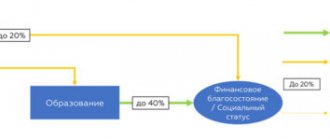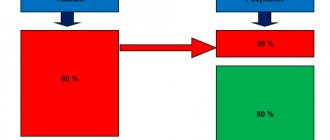A person's individuality is not just a pretty expression. By nature, all people are truly special. These features are embedded in the human psyche, which forms temperament and character.
What are these personality traits that psychologists so often talk about and advise taking into account when choosing a profession and life path? How to use knowledge about the characteristics of temperament and character for good, to achieve success? And how to determine your type of temperament and dominant character traits and, if necessary, correct them? Psychologist-coach Maria Roshchina these questions to the FAN .
photo from the personal archive of Maria Roshchina /
What is temperament and character
Science believes that temperament plays a primary role in the formation of individual personality traits. It is what is called the “biological foundation” on which personality traits are built: stability of emotions, impressionability, energy, adherence to a certain pace of life, reaction to external factors.
Temperament can be considered an innate tendency - it does not change over the course of life. It also determines the characteristics of a person’s behavior and reactions, regardless of what activity he is engaged in.
Among the properties of temperament are:
- reactivity - the degree of a person’s reaction to an external stimulus, be it an event or an offensive word thrown at him;
- activity - energy, which shows how intensely a person strives to influence the outside world;
- plasticity - the ability to adapt to external conditions and obey them;
- rigidity - inertia of behavior in a given situation;
- emotional excitability - the strength of the emotional reaction and the speed of its occurrence.
On the basis of these mental traits, character is built - a system of human characteristics that shows or allows one to predict his actions and behavior in a specific situation. Speaking about character, we mean a set of traits that are most noticeable in a person’s behavior, for example:
- frivolity or thoughtfulness;
- courage or cowardice;
- conscientiousness or lack of seriousness in performing work.
“A person needs character in order to survive in the world and society,” comments psychologist-coach Maria Roshchina. — One of its frequent manifestations is heroism. A person strives to be a hero, and this is natural, since it brings satisfaction. But since there are few opportunities for heroism in everyday life, people tend to create such situations. Examples of this include fashion, television, religion, and supporting your favorite sports team. By joining one of the “trends,” a person can feel like a hero without doing anything heroic.”
Can a person change his temperament?
Psychological well-being, determined by life circumstances, is mainly associated with the type of personality temperament. But the external manifestation of a person’s condition largely depends on his upbringing, beliefs, attitude towards other people or current events. By mobilizing his energy, he is able to withstand prolonged mental stress, influence the speed of reactions and the overall pace of work.
For example, upbringing and will help a choleric person to be restrained and to switch thoughts to other events and tasks.
By replacing the weak sides of his temperament with a system of volitional training, education and environmental influences, a person can radically change its external manifestation. Under certain living conditions in which a person spends a long time, a choleric person can become inert and slow, while a melancholic person can become energetic and decisive. The true natural properties of temperament can only appear under unexpected strong influence or a dangerous life situation, when the external factors with the help of which it was previously changed lose their meaning.
We recommend that you read: Causes and consequences of Stockholm hostage syndrome
What is the difference between character and temperament?
Hippocrates spoke about the differences between people, embedded deep in their nature . Back in the 5th century BC, he proposed a classification that formed the basis of the typology of temperaments generally recognized today.
Depending on the complex of mental properties of a person, four types of human temperament are distinguished.
- Sanguine . Such people are characterized by exceptional activity. They quickly respond to events happening around them and strive for frequent changes of impressions. The failures that befall them are easily overcome: they simply step over and move on. Their lives are busy, their facial expressions are expressive, in communication they strive for leadership, and their reaction often depends on external, so-called situational impressions.
- Phlegmatic . People with such a mental organization are characterized by equanimity. They are constant in everything, from the manner of communication and the prevailing mood, to life attitudes and priorities. They are persistent, resistant to stress, do not tend to show emotions, and are reserved in conversation. External influences are rarely able to make phlegmatic people lose their temper. They are not inclined to respond to new impressions and have difficulty meeting new people.
- Choleric . Energy and a desire to embrace the immensity characterize people with this type of temperament. They are prone to violent expression of emotions, quick and impetuous, their mood often changes, and they devote themselves entirely to a new task with real passion, while often quickly cooling down and losing interest. Outwardly, a choleric person can be distinguished by rapid movements and emotional speech.
- Melancholic . Their mental organization is delicate and vulnerable. These are impressionable, deeply emotional, compassionate people who have difficulty finding a common language with colleagues and peers. They prefer loneliness to communication, they take failures seriously, and analyze for a long time, trying to determine their mistakes. They react to external factors taking into account past experience. They are calm and restrained in behavior, their speech is quiet and muffled.
“People who are prone to compassion and self-sacrifice are often bullied in society,” noted psychological coach Maria Roshchina. “They don’t give change, and if they experience negative emotions, they show them by being upset and crying.” This becomes a motivating factor for the “sadist”. Therefore, in children’s groups, those children who begin to cry faster than others are more likely to suffer from the aggression of others.”
pixabay.com/
The influence of temperament on character
The characteristics of temperament do not change over the course of life, becoming the basis of character. What is given to a person by nature determines the basis of his behavior, his inclinations, things that are given to him easily and, on the contrary, difficult.
For example, a lively and sociable sanguine person calmly finds a common language with any people, but at the same time it is difficult for him to complete a monotonous project. In this case, we can talk about restlessness as a character trait.
A choleric person, as a man of action, will immerse himself in work that interests him, but one can hardly demand attention from him towards his loved ones, that is, caring. It is much more difficult for a phlegmatic person to show initiative and determination compared to a self-confident sanguine person. A melancholic person is prone to timidity and anxiety, which are very difficult for him to overcome.
The role of temperament in character
Of course, people of different temperaments can have similar character traits. But their behavior even in situations that are close in meaning will be different. For example, both a choleric person and a melancholic person may experience suspicion towards the people around them. But if a melancholic person tries to completely stop communication with a suspicious person, to isolate himself from him, then the choleric person will try to give him a chance, if this is necessary for the business.
Perseverance also manifests itself differently in people of different temperaments. If a phlegmatic person works slowly but persistently and methodically to achieve a goal, then a choleric person will try to act energetically, aggressively, often impudently, and, if necessary, go over their heads.
At the same time, a tendency towards a certain model of behavior does not mean at all that a person cannot adjust the characteristics of his personality - quite the contrary.
Fact . The ability to control manifestations of temperament becomes an indicator of the social maturity of an individual. In this case, a system of character traits developed over the years, filled with life aspirations, subjugates those manifestations of temperament that interfere with achieving goals.
pixabay.com/
Types of temperament and character in psychology and business
In addition to the classical system of dividing temperaments, there is another one, which is often used in business. With its help, you can form a team that will successfully achieve your goals.
“Depending on their temperament, people are assigned a certain color,” notes Maria Roshchina. “Based on your color, you can judge what type of activity is ideal for you.”
- Yellow . People of this color are called interested. They are kind, friendly, caring. They are often characterized by shockingness and a penchant for creativity. In a team, they become the “sun” to which everyone else is drawn.
- Blue . Such people know how to work and relax. They have excellent analytical skills, so they quickly find errors and can direct the project work in the right direction. In their free time, they are true party people, they easily switch their attention from office routine to relaxation and know how to relax.
- Reds . These are born leaders, ready to go above and beyond and move any project forward like a powerful locomotive. They are aggressive in their work and decisions, and are often not inclined to listen to other people’s opinions, since they always know what is best, what is right and what to do next.
- Greens . In the team they may be considered nerds and quietly laugh at them. But no one will doubt their value as employees. These are excellent performers, diligent, always finishing everything. At the same time, they are non-conflict, kind and responsive, and therefore are able to win over anyone.
“When creating a team, put the “red” at the head,” advises psychologist-coach Maria Roshchina. “He will move forward like a locomotive and will take the team to a new level. Then it’s the Blues’ turn. Several of these employees will analyze and find mistakes made by the “red” ones and will not allow the project to go off the intended “rails”. “Yellow” is also needed, this is the “firefly” in the team to which everyone is drawn. He plays the role of a motivator. And recruit as many “green” — diligent performers — as possible. This way, your team will be properly staffed and produce results.”
pixabay.com/
Character traits and temperament properties
The first character traits based on temperament appear already in infancy, and by adolescence many of them become stable. At the same time, the relationship between character and temperament manifests itself in all aspects of a person’s life, forms the principles of his behavior, dictates interests, desires and actions.
Manifestations of character can be expressed in relation to oneself and the people around you. Tactfulness or rudeness, the desire to help loved ones or unwillingness to see other people’s difficulties, stable attachment or the ability to easily part with people determine the characteristics of a person’s communication.
Other character traits show his attitude:
- towards oneself - self-confidence or a tendency to self-flagellation;
- to the point - conscientiousness and responsibility or a tendency not to go into details and always rush;
- to things - neatness or negligence, respectful or not very respectful attitude towards other people's property and cultural values.
Character traits lay down behavior programs. And if the program is formed, this is exactly how a person will act in typical situations. Moreover, in childhood and adolescence, these “programs” are amenable to external adjustment - through the efforts of educators, teachers, parents, and psychologists. In adulthood, a person, as a rule, tends to follow accepted programs of action and change them only if he understands that they interfere with achieving his goals.
What personality traits might there be?
These include
– integrity, determination, honesty, courage. It is clear that character traits can also contain the opposite of these, that is, negative qualities - unprincipledness, deceit, passivity. The second group consists of character traits. In which a person’s attitude towards other people is expressed.
Interesting materials:
How long can you take Creon? How long can you take Xarelto? How long can you take magnesium B6? How long can you take Motilium? How long can Nebilet be taken? How long can you take Paxil? How long can you take Rigevidon? How long can you take hydrogen sulfide baths? How long can you take Tabex? How long can Teturam be taken?
Temperament and character accentuations
Accentuations are situations when one or another trait in a person’s character prevails over others - for example, a tendency to self-criticism, self-sacrifice, or pronounced negligence. Such a character imbalance is not recognized as a disorder in psychology, but it can create a lot of problems for a person and the people around him. It becomes difficult to communicate and work with him; at the same time, accentuation prevents a person from correctly assessing himself and deprives him of opportunities for harmonious development.
Accentuations do not depend on the type of temperament and can appear in both sociable sanguine people and closed melancholic people. Usually they do not dictate rules of behavior and do not appear constantly, but only from time to time, in connection with a specific situation or environment. As a rule, accentuations develop in adolescence and smooth out as a person grows older.
Borderline states with pronounced temperament
When neurochemical systems are extremely imbalanced, temperament types manifest as psychiatric profiles.
| Temperament type | Borderline state | Symptoms |
| Choleric | Impulsive personality disorder | Uncontrolled attacks of anger, short temper, inciting quarrels and conflicts over nonsense. |
| Phlegmatic person | Schizoid personality disorder | Withdrawal, escape from reality, isolation, and then complete closure. |
| Sanguine | Hypomania | Cheerful mood, denial of problems, energy, feeling of complete well-being, euphoria. |
| Melancholic | Anxious personality disorder | Extreme vulnerability, inferiority complex, constant fear. |
Character temperament test
There are several tests that help determine the type of temperament and predict a person’s character and behavior in the future. Most often, psychologists use such questionnaires.
- Eysenck Personality Questionnaire. It was compiled by the British psychologist Hans Eysenck in the middle of the last century, but not only has not lost its relevance, but also remains the most frequently used test in this area. It includes 57 questions, answering which a person indicates his characteristic principles of behavior in specific situations. It takes 10 minutes to fill out. When determining the result, they are guided by the extraversion and neuroticism scales.
- Belov's temperament formula. Includes four tables with yes or no questions. Depending on the total number of pluses (positive answers) in each of the tables, the dominant type of temperament can be determined.
- Strelyau questionnaire. Compiled by Polish psychologist Jan Strelyau to determine the characteristics of the nervous system of the subject: the tendency to excitation and inhibition. He developed his own system of temperaments, which differs from the generally accepted one, but allows one to determine whether a person is an extrovert or an introvert. The questionnaire contains 134 questions, you need to answer them “yes” or “no”.
pixabay.com/
Is there a pure temperament?
The Soviet and Russian school of psychology is based on the works of I.P. Pavlov. The great scientist was not a psychologist. He conducted his famous experiments on animals. Studied physiological reactions to stimuli.
Two processes can occur in the nervous system: irritation and inhibition.
These processes are characterized by the following features:
- force;
- equilibrium;
- mobility.
Their opposites:
- weakness;
- imbalance;
- inertia.
Balance and imbalance characterize the ability to maintain a reflex or quickly transition to another state.
I.P. Pavlov identified three types of strong nervous system and one weak one. Since the weak type responds to stimuli with inhibition, the characteristics of mobility and balance cannot be applied to it.
Thus, four physiological types of the nervous system were identified.
The description of the types of the nervous system coincided with the tradition dating back to antiquity.
I.P. Pavlov believed that the weak type should disappear in the process of evolution. But research shows that there are more melancholic people than choleric and phlegmatic people.
Temperaments are practically never found in their pure form. Later it was recognized that there are more than four stable combinations of various properties of the nervous system. When studying human nervous activity, complex processes were identified that were different from simple reflexes.
Personality orientation, character and temperament
Taking into account the personal characteristics of a person, you can help him achieve success in life, achieve better results, and become successful in school and work. The basis of personality orientation is motivation, which implies satisfaction of needs.
Some people are quite satisfied with satisfying only physiological needs. They are characterized by inertia and unwillingness to change anything in life. This type of behavior can form a melancholic person.
Other people are interested in realizing their own creative potential, satisfying social needs for communication, social growth, which is typical for sanguine and choleric people. But the direction of personality can be coordinated, regardless of the initial temperament. You just need to act differently in each case.
Sanguine - “trust, but verify”
Sanguine people tend to get carried away and always happily respond to everything new in life. Their responsiveness and sociability become the basis for their success. But exactly until they turn into frivolity, over-communication and unreliability.
The principle of working with a sanguine person is control and verification, since he does not always fulfill what he promises. Frivolity can be harmful, so it is important for sanguine people to instill perseverance and the habit of finishing what they start.
Choleric - “not a moment of peace”
The best option for developing the personality of a choleric person is to use his vigorous energy to the fullest. Such a person must be busy all the time. His energy is enough for everything: studying, playing sports, meeting with friends, working.
As long as he is passionate, he is cheerful, achieves his goals and, most importantly, they come easy to him. If a choleric person finds himself “out of work,” he begins to demonstrate temperament, aggression, incontinence, and conflict. In a team, he may well direct his energy in a dangerous direction - to destroy the built system, so by loading him with several projects, you can avoid such a danger.
Phlegmatic - “don’t rush”
Phlegmatic people seem slow and “thick-skinned,” but at the same time they are constant, patient, and most importantly, reliable. To help a phlegmatic person show his positive qualities, he cannot be rushed. In conditions of time shortage such a person cannot work. And if you don’t push him, but give him the opportunity to work at his own pace, he will do the job perfectly.
Melancholic - “do no harm”
People around me strive to take advantage of the goodwill and ability to sympathize with melancholic people. Their gentleness and humanity are good within the family, but in society they often become victims of aggression or submit to other people's demands. Their vulnerability and shyness interfere with achieving success, so when shaping the orientation of a melancholic person, one must be careful.
Shouting, pushing, setting strict limits is not for them. The attitude should be soft, and when communicating with a melancholic person, it is important to maintain a positive attitude, since he is sensitive even to the intonation of speech.
“Contact a psychologist to analyze your team,” advises Maria Roshchina, “and distribute tasks so that all its members rush to work and want to show results.”
Talent and genius
Abilities can be general or specific. General ones are related to the activity and energy of the body. Special ones appear as narrowly focused. For example, the combination of active and thinking types creates the prerequisites for success in any type of activity.
The presence of specific inclinations will allow you to specialize in a narrow area.
All people have general and special abilities to varying degrees.
Talent can be called a combination of specific types of giftedness with a strong personality type. The ability to concentrate is important.
The illustration shows one of the classifications of talents accepted in psychology.
Genius is the highest manifestation of specific talent combined with high intelligence.










